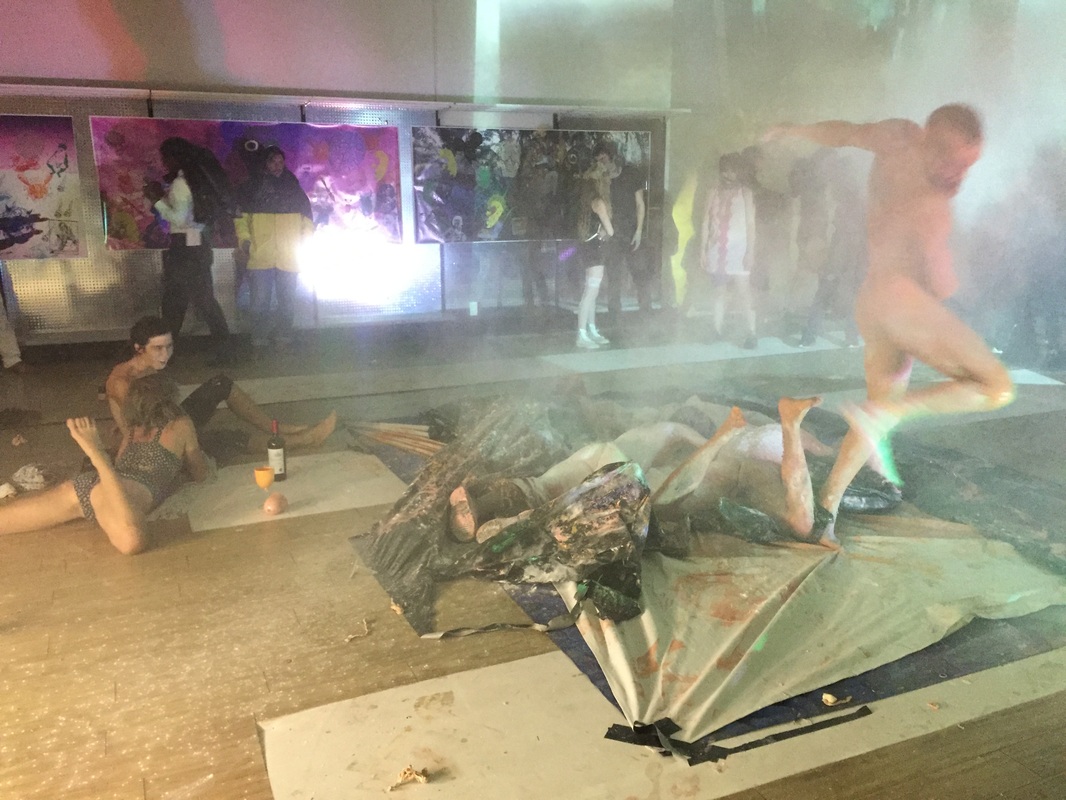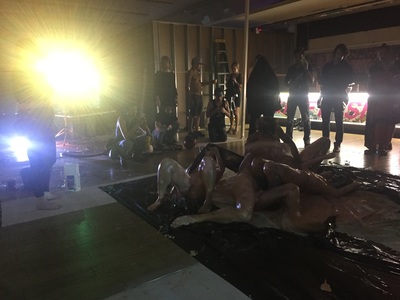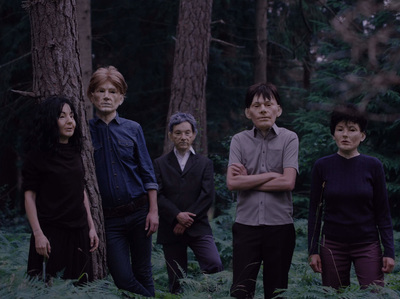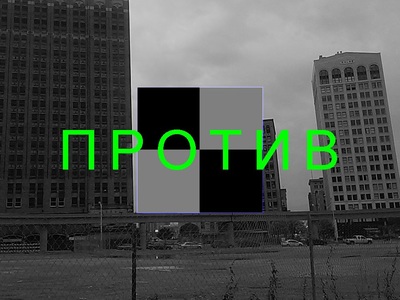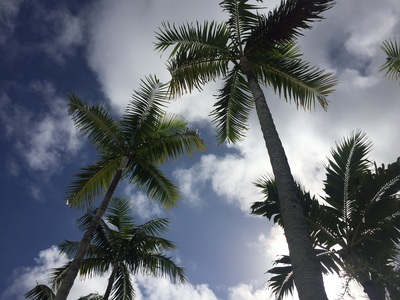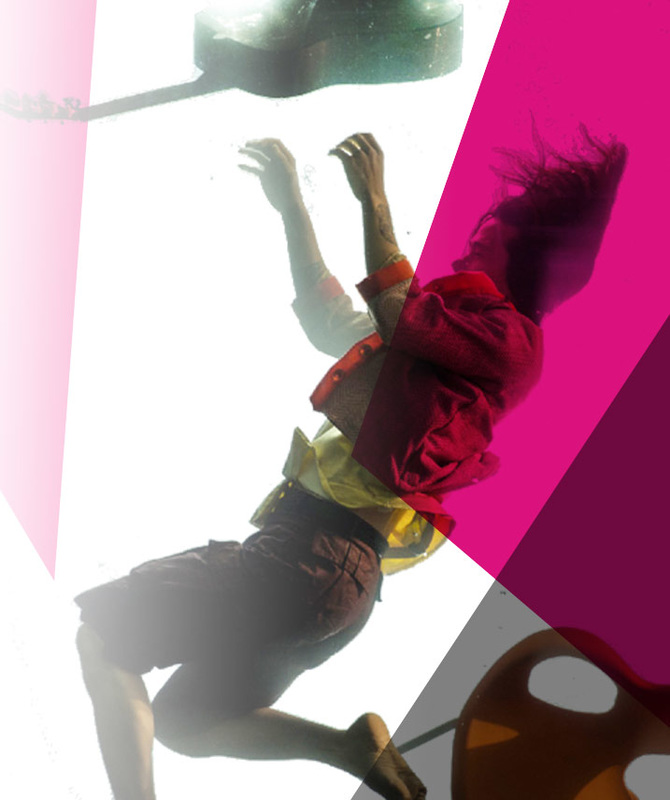|
Interview with Carlos Martiel By Quinn Dukes This year performance art pervaded Miami Art Week 2015 (for better and for worse). Most notably at the non-traditional, multi-destination, Satellite Fair organized by Brian Andrew Whiteley and the curatorial project "Time Sensitive" curated by Jesús Fuenmayor at Pinta Miami. As you can imagine, the sheer density of events, shows and performances prohibited us (Alexandra Hammond + myself) from being able to view the full performance roster at either fair but we were determined to catch Carlos Martiel's durational work at Pinta Miami. Martiel caught my attention last October for his durational performance, "Segregation" at Samson Projects (Boston) where he stood motionless between two layers of barbed wire. Upon entry, audience members were separated by country of origin and viewed the performance from opposing sides. Martiel notes on his website, "One of the entryways permitted the entrance of U.S. born whites and Europeans. The other, permitted the entrance of blacks, latinos, asians, and middle easterners, as well as any individual who was not European or U.S. born white. People were not allowed to mix for the duration." Similar to "Segregation", Martiel's arresting performance at Pinta Miami offered viewers an opportunity to deeply contemplate personal and political freedom both as an individual and within a larger, social contstruct. As a former pupil of Tania Bruguera, his performance philosophy should come as no surprise - but I find Martiel exceedingly daring - willing to acknowledge and face consequence. This is no easy feat within commercial performance/performer relationships. Following his Miami performance (Dictadura), I reached out to Martiel to learn more about his pre-performance preparations and post-performance insights. I am honored to share our conversation with you as a part of this week's Artist Feature. -Quinn Dukes QUINN DUKES: What led you to create Dictadura? CARLOS MARTIEL: At first, when I was invited to make a performance work for PINTA in Miami, I wanted to do a project that had a relationship with Cuba, given the number of Cuban exiles who are in this context, most of whom were fleeing Cuba from the current political regime. During the research process for the project, however, I decided to include a larger number of countries in Latin America that have also had some form of dictatorial regime just like the case of Cuba. But unlike Cuba, the vast majority were supported by the School of the Americas, now known as the Western Hemisphere Institute for Security Cooperation. In the United States, many people have no idea about the history of Latin America, or the macabre role the United States played in inflicting pain to the Latin American family, with its foreign policy of transforming Latin American military apparatuses into one of torturers, murderers and dictators. It was because of this that I created the project. I remained still, retained by the neck to a steel collar bolted to the base of a flagpole, forced to stare at the alternating flags of the countries of Latin America and the Caribbean, where dictatorial regimes have had support in some form by the School of the Americas. Each flag was placed for an hour and in historic chronological order, just as if the dictatorships were happening in real time. QD: How did you prepare for the durational aspect of the piece? CM: I really don’t have particular rituals for the preparation of my work. Usually I try to spend an hour alone, before making my performances, but it's not something I can always do. I believe that no preparation is sufficient to deal with the types of works I engage with, the challenge is actually at the time the work is presented in real time and the strategies that you develop internally as the work is happening, for example, careful breathing to avoid discomfort, uneasiness or tingling so that I stay focused. QD: Stillness and duration are commonly core elements to your performances. What draws you to these two methods? CM: I grew up in a society that lives on the edge in many respects, an island surrounded by water, people who endure a lot of financial hardships and even complete lack of basic needs, but must continue to live one way or another and not give up. This has influenced much of the durational aspect of my work. I have also studied and I am very familiar with African cultures and rituals of initiation, where one has to test the physical and psychological limits of the initiates. I believe that we should approach as much as possible to our limits, because only from there life can be seen through different eyes, and perhaps felt with a different kind of skin. QD: Where there any challenges to performing in the context of an art fair? CM: This was my first time participating in a fair doing a performance. It is a difficult experience because some people involved in organizing such events do not understand the nature or dimensions of a performance. For example, they wanted to reduce the performance which was suppose to last 21 hours, divided into seven days, only to three days for economic reasons ... I did not allow that to occur. If one wants to keep an initial idea and be consistent with what one is proposing, you have to be very firm. The relationship with the audience is also very different. I was surprised for example that people came to my performance and took selfies like if the performance was something to hang on a wall like a painting. QD: How did you connect with Pinta Miami? CM: I received an invitation by curator Jesús Fuenmayor to participate in his “Time Sensitive – Pinta Projects”. QD: I see that you have presented performances across the globe. In your experiences thus far, does the reception of your work change per location? Can you offer a few examples? CM: My work does not go in one direction, it is a fluid experience that changes depending on where I live, but also changes depending on the context where the performances take place. I think change gives richness and variety to my work, and better enables me to avoid common clichés. For example, on several occasions I have worked with the theme of emigration and immigration, but I address these topics from different perspectives each time. In Cuba, I made “Where My Feet Do Not Reach” in which I was interested in the idea of traveling through the subconscious of people who could not leave the island. For the Liverpool Biennial, I performed “Horror Vacui,” in which I dealt with the same issues from the point of view of the immigrant who is to assimilate into a different culture. In this context, I sewed onto my skin different parts of a classic English suit. In “Simiente,” a work I performed in Chicago, I wanted to unite in one body the blood of different immigrants living in Chicago, a city that has a large population of immigrants, but all segregated. QD: Is your practice exclusively rooted in performance? If so, what brought you to this methodology? CM: For the time being, I am working with my body and the possibilities that it brings as living matter. I am open to work with other media but it depends more on the ideas than a specific practice. For example, while I was living in Cuba in early 2007 I made a series of drawings with my blood. I would go to public clinics and ask the nurses to draw blood from me, clandestinely, so that I could use it in my work. Sometimes the nurses would refuse or they would not retrieve an adequate quanitity of the blood that I needed for my drawings so this created a big frustration for me. One day, I realiized that time and the body are extrememly important elements for the type of work I wanted to realize and so I decided to make my first performance. Since then, I’ve been working with the body and performance as my practice. QD: Are their any current performance practitioners that inspire you? CM: I really do not receive inspiration from performance artists, I am moved by the reality around me, I am inspired by human contradictions, social problems that I cannot believe have not been resolved yet like immigration, police brutality, racism, to just mention a few... I am inspired by writers like Eduardo Galeano or singers like Mercedes Sosa and Lola Flores. But I do think that there are perfomance artists whose work I find attractive given the content and the vivacity of the work. For example, Paulo Nazareth, Tania Bruguera, Regina Galindo, and Santiago Sierra. Special thanks to Martiel's translator: Jorge Sánchez images from Carlos Martiel's performance Dictadura at Pinta Miami, 2015. // images courtesy of Q. Dukes
1 Comment
Bushwick-based Wild Torus’ baccanale at The Pharmacy (one of Satellite Art Fair’s 2015 Miami art week locations and an actual former pharmacy) culminated in 5-7 naked performers writhing and wrestling (lube, paint and flour-covered) on a square dance floor covered in garbage bag-like plastic tarp. Viewer-participants (participation is encouraged at Wild Torus happenings) were offered black trash bags to cover their art-fair finery so that they could stand at close range without being completely dusted by flour or splattered with paint and lube, which was being doled out in plastic wine glasses by two young men with shaved heads. These attendants were encouraging in spite of what could be read as an intimidating appearance: tall, wiry, shirtless and vaguely punk, wearing jean cutoff shorts. They encouraged viewers to pour the fluids over the wrestling, contact-improvisational knot of bodies on the mat. Flour and fluids: poured on by turns, lubing up the orgiastic mass and then powdering it down. On the wall behind, a video projection of the live action spanned nearly from floor to ceiling, offering the option to experience the scene at hand as a mediated spectacle. This was Miami art week after all, and many of us who were visiting art fairs had spent plenty of time in recent days looking at and snapping shots of artworks through the screens of our smartphones. For a performance collective that specializes in viewer participation, the video projection was an apt comment on touristic looking vs. bodily engagement. Both were available modes of interaction with the work, though most viewers seemed to be compelled by the live action. One might rightly question the relevance of Wild Torus’ work more than 50 years after Carolee Schneemann's Meat Joy, Allan Kaprow’s happenings and countless other examples of live art with multiple bodies. But for those of us too young to have attended these now historic performances, the relevance is that we get to experience such a performance in real time and in the flesh. It is one thing to know that such events have taken place in the history of art, and entirely another to negotiate the the social situation generated by the live action. And in spite of the orgiastic, chaotic character of Wild Torus’ performance, it is the subtle social negotiations that make it interesting. Within our culture of internet pornography, media spectacle, and a half-century of body art, the shock value of coed naked wrestling is negligible. What remains potent is the negotiation between Wild Torus members and audience members as they are invited to participate in the performance ritual. Does one feel coerced, uncomfortable, excited by the invitation to pour flour and paint on the performers? Does one put on the garbage bag poncho so that one can stand close to the action, or does one keep one’s distance so that one’s clothes and shoes stay clean? Does one, in fact, jump into the action on the mat? These options are all available for the viewer / participant. Even more than the content or choreography of the Wild Torus performance, it was the exposition of these choices that was of interest. The performance highlighted the fact that we are constantly negotiating our engagement with other bodies in space and that the boundaries of this engagement are up to us. - Alexandra Hammond, Miami Art Week Correspondent for Performance Is Alive December is an active time for performance art events in NYC! Here is a sampling of events that we recommend!
Scoping out the live performance events during Miami Art Week (aka Art Basel Miami) is no easy feat in a mass of object-based exhibitions! But we are committed to this mission and recommend the following performance events thru the lasting duration of the week. Hope to see you there and stay tuned for our performance recaps! - Quinn Dukes + Alexandra Hammond
Performance Is Alive is in Miami for Miami Art Week 2015! We are thrilled to introduce Alexandra Hammond, our Miami Art Week performance correspondent. In true Performance Is Alive fashion, we interviewed Hammond to learn more about her background, thoughts on the art fair model and of course, performance art! Enjoy the interview below and stay tuned on our Facebook and Instagram page for live updates.
|
CONTRIBUTORSIan Deleón Archives
July 2023
|
|
MISSION // Based in Brooklyn, NYC, PERFORMANCE IS ALIVE is an online platform featuring the work and words of current performance art practitioners. Through interviews, reviews, artists features, sponsorship and curatorial projects, we aim to support the performance community while offering an access point to the performance curious.
Performance Is Alive is a fiscally sponsored project of Fractured Atlas, a 501(c)(3) charity. Contributions made payable to Fractured Atlas for the purposes of Performance Is Alive are tax-deductible to the extent permitted by law. |



